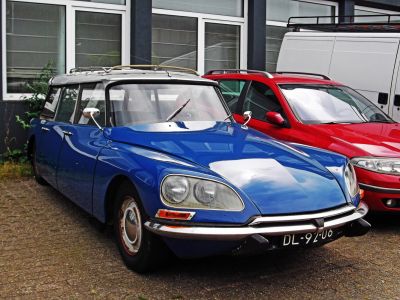 1972 Citroen DS Break Dimensions, Size & Specs
1972 Citroen DS Break Dimensions, Size & SpecsMeasurements of the 1972 Citroen DS Break, engineered for optimal performance and comfort
| Dimensions | |
|---|---|
| Length: | 5026 mm197.9 in16.5 ft |
| Width: | 1803 mm71.0 in5.9 ft |
| Height: | 1530 mm60.2 in5.0 ft |
| Ground Clearance: | 145 mm5.7 in0.5 ft |
| Trunk Capacity (Max): | 1900 liter67.1 cu ft |
| Weight Specifications | |
| Curb Weight: | 1435 kg3164 lbs |
| Maximal permitted Weight: | 2075 kg4575 lbs |
| Roof Load: | 80 kg176 lbs |
The Citroën DS Break, produced from 1972 to 1975, is a remarkable example of French automotive design blending practicality with distinctive style. As a station wagon variant of the legendary Citroën DS series, the DS Break offers substantial cargo space, making it ideal for families or those needing generous storage. Measuring 5026 mm (197.8 inches) in length, 1803 mm (71 inches) in width, and 1530 mm (60.2 inches) in height, it presents a balanced yet spacious footprint that stands out among station wagons of the early 1970s.
With a curb weight of 1435 kg (3162 lbs) and a maximum permissible weight of 2075 kg (4575 lbs), the DS Break handles its mass with Citroën's famed hydropneumatic suspension system, ensuring a smooth ride over varied road conditions. The vehicle boasts a ground clearance of 145 mm (5.7 inches), providing adequate clearance for urban and countryside use.
One of the standout features of the DS Break is its impressive luggage capacity. When the rear seats are folded down, the cargo area expands to a massive 1900 liters (67 cubic feet), enabling the transport of bulky items with ease. Additionally, the roof load capacity of 80 kg (176 lbs) allows for extra storage solutions such as roof racks, further enhancing utility.
Overall, the 1972-1975 Citroën DS Break stands as a versatile and spacious station wagon from a golden era of automotive history, combining innovative engineering, generous dimensions, and practical design to meet the needs of drivers seeking comfort and functionality.
Discover the standout features that make the 1972 Citroen DS Break a leader in its class
Have a question? Please check our knowledgebase first.
The Citroën DS Break from 1972 to 1975 is a spacious station wagon with a length of 5026 mm (197.7 inches), a width of 1803 mm (71 inches), and a height of 1530 mm (60.2 inches). These dimensions provide a commanding presence on the road and ample interior space, especially for passengers and cargo. The DS Break's extended length compared to the sedan makes it one of the larger family wagons of its era, blending practicality with the iconic Citroën design.
The Citroën DS Break weighs in at a curb weight of 1435 kg (3,163 lbs) and a maximum permissible weight of 2075 kg (4,577 lbs). This weight balance was carefully managed in the DS Break to maintain the vehicle's renowned ride quality and handling dynamics, aided by its advanced hydropneumatic suspension system. The difference between curb and maximum weight means the DS Break can effectively carry substantial loads or passengers without compromising stability, making it a practical yet comfortable choice for long-distance touring or family use.
The Citroën DS Break has a ride height or ground clearance of 145 mm (5.7 inches). While this might seem modest, it is sufficient for typical urban and light rural driving conditions. The hydraulic suspension system also allowed drivers to adjust the height for loading or rough terrain, improving versatility. This ground clearance combined with the DS’s innovative suspension gave the DS Break an unparalleled smooth ride and the ability to handle uneven roads better than many competitors.
One of the standout features of the Citroën DS Break is its impressive luggage capacity. With the rear seats folded down, the vehicle offers a generous cargo space of up to 1900 liters (67.1 cubic feet). This ample storage volume makes the DS Break highly practical for families, long trips, or transporting bulky items. The flat loading floor and wide rear access further simplify the process of accommodating and securing luggage, highlighting the Break’s role as a versatile station wagon.
The Citroën DS Break measures just over 5 meters in length (5026 mm or 197.7 inches), which is relatively long for a station wagon. Most standard residential garages have internal depths ranging from around 5.5 to 6 meters (18 to 20 feet), so the DS Break can fit into a typical garage but with limited extra space for maneuvering or storage around the vehicle. Its width of 1803 mm (71 inches) is also fairly standard and should pose no issues in terms of width clearance in garages designed for modern vehicles.
The DS Break introduced in 1972 was an evolution from earlier DS estate variants, continuing Citroën’s trend of offering spacious, innovative wagons. Compared to prior generations, the 1972-1975 DS Break maintained and slightly refined the key dimensions, with a length of 5026 mm providing plenty of cargo room. While the core design philosophy remained consistent, improvements in suspension and overall engineering made the later DS Break more comfortable and reliable. Dimensionally, the car was quite consistent with its predecessors but benefited from small enhancements enhancing usability.
Compared to other station wagons from the early 1970s, such as the Peugeot 504 Estate or Volvo 145, the Citroën DS Break stands out with its distinctive length of 5026 mm (197.7 inches), advanced hydropneumatic suspension, and superior cargo capacity of up to 1900 liters. Many contemporary wagons offered robust size but lacked the ride comfort or innovative technology of the DS Break. Its width of 1803 mm (71 inches) was fairly typical, but the DS's unique suspension and styling gave it an edge in both comfort and visual appeal in the market segment.
The maximum roof load capacity of the Citroën DS Break is 80 kg (176 lbs). When planning to carry roof-mounted cargo such as luggage racks or sports equipment, this limit should be respected to maintain vehicle stability and safety. Excessive loads can affect the vehicle’s handling dynamics, especially given the hydropneumatic suspension system designed for smooth rides. Efficient packing and balanced distribution of load will help preserve the DS Break’s excellent driving characteristics while maximizing usable storage.
The Citroën DS Break was unique for its era due to its combination of ambitious length, spacious interior, and innovative suspension system. The overall length of over 5 meters offered space usually found in larger vehicles, yet Citroën’s signature hydropneumatic suspension ensured exceptional ride comfort and adjustable ground clearance. This blend of size and advanced technology meant the DS Break could comfortably handle heavy loads or rough roads without sacrificing passenger comfort, a significant advantage over more conventional wagons that lacked such adaptability.
With its sizeable dimensions, 1435 kg (3163 lbs) curb weight, and advanced hydropneumatic suspension, the Citroën DS Break is well-suited for long-distance touring, family road trips, and carrying substantial luggage or equipment. The adjustable ground clearance and load capacity make it versatile across urban roads and light rural terrain. Its size and comfort settings are optimal for drivers valuing smooth rides and spacious interiors, while the weight distribution supports stable handling under varied load conditions, making it a practical classic vehicle for diverse driving challenges.
Discover similar sized cars.

| Production: | 1967-1975 |
|---|---|
| Model Year: | 1968 |
| Length: | 5040-5050 mm198.4-198.8 in |
| Width: | 1803-1815 mm71.0-71.5 in |
| Height: | 1530 mm60.2 in |
